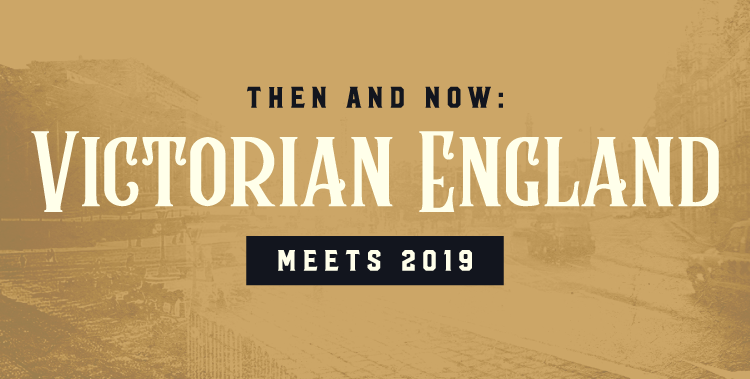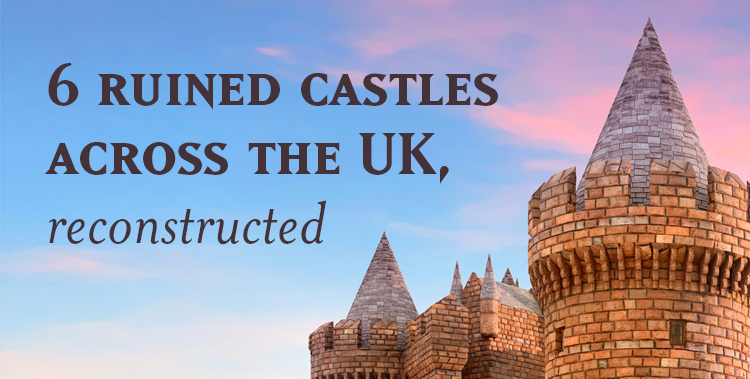Disclaimer: This post was originally published on our UK partner’s site.
Short of inventing yourself a time machine, it’s difficult to picture precisely how England’s cities have changed since Victorian times.
But thanks to the wonder of archive images and our roving photographers, we’ve created a new set of interactive images that will instantly transport you back 125 years to the altogether quieter street life of England at the end of the 19th century.
Bristol – St. Augustine Parade
Saint Stephen’s church remains a constant on Bristol’s skyline – in fact, it’s been there since the year 1470! For several centuries the church tower was a landmark that seafarers could use to guide themselves to Bristol Harbour. Today, it’s tucked behind taller developments such as Colston Tower (to the left of the modern image). But the most significant detail to have changed from photo to photo has been there even longer: the River Frome has disappeared from sight since this part of it was covered over in 1938, one of the latest developments in a long history of diverting and culverting the river to boost trade around the harbour.
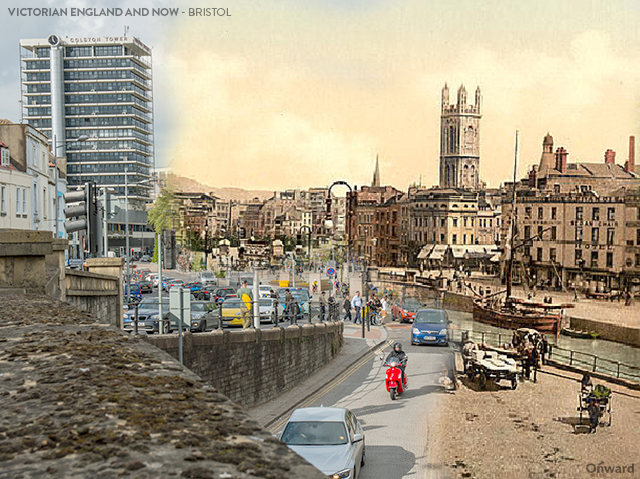
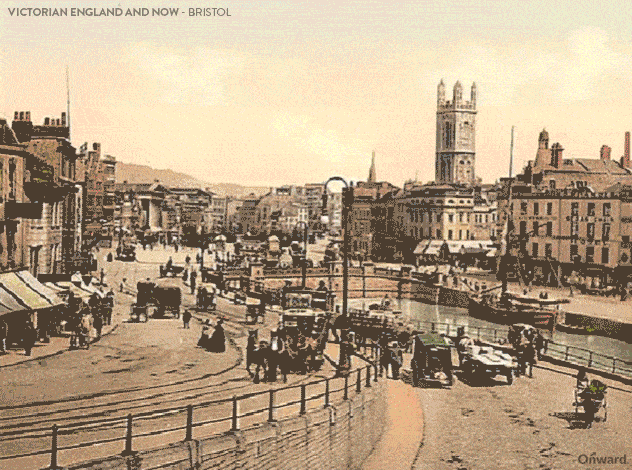
Click on the image to see more
Liverpool – St. George’s Hall
The area between Lime Street railway station and St George’s Hall opposite (on the left of the picture) is a rare example of a barely-changed landscape in this part of the city. The area of Lime Street around the corner from the gothic buildings has been radically transformed in the last few years, while if you were to turn 180 degrees and walk into the shopping district, you’d find it barely recognizable compared to a decade ago – before the redevelopment of ‘Liverpool One’. Talking of 180-degree turns, the Neoclassical pomp of St George’s remains exactly where it stood when it opened in 1854 despite a persistent urban myth that it was accidentally built back-to-front.
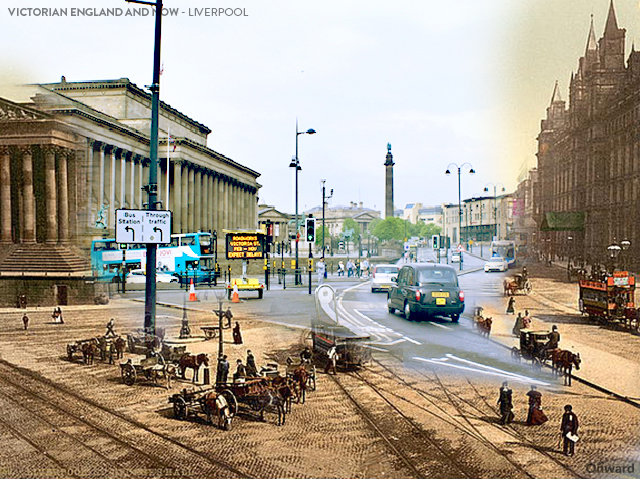
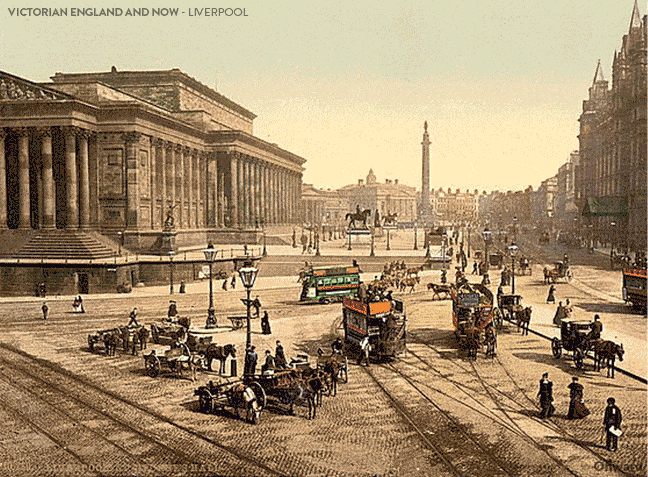
Click on the image to see more
London – Victoria Embankment
There’s a surprisingly ancient piece of history in these photos: the obelisk in centre-frame is the 3,500-year old ‘Cleopatra’s Needle’ offered by Egypt to Britain as a gift in the 19th century AD. It remains sadly overlooked in 2019 as officials resist pressure to celebrate the 200 year anniversary of the gesture. Waterloo Bridge beyond is a far newer landmark but with a more eventful history: the version in the Victorian photo was demolished in the 1930s, and rebuilt by a team of women during the Blitz (it took a while for their story to emerge due to statements like then-Deputy Prime Minister Herbert Morrison’s: “the men that built Waterloo Bridge are fortunate men.”) It was the only Thames River bridge to incur damage from German bombs. More recently, it was the site of the major global warming protests of Extinction Rebellion.
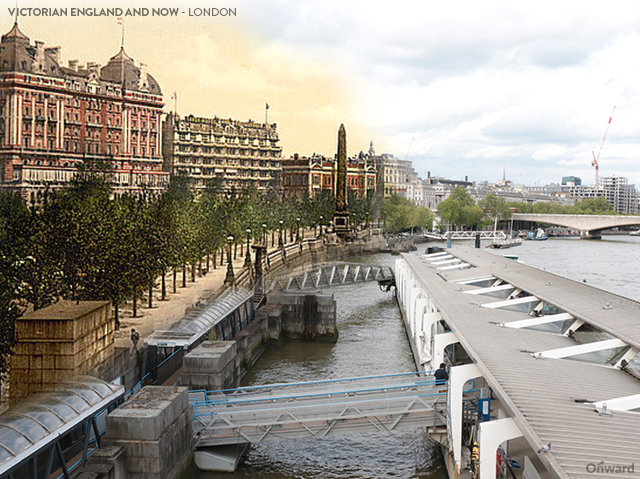
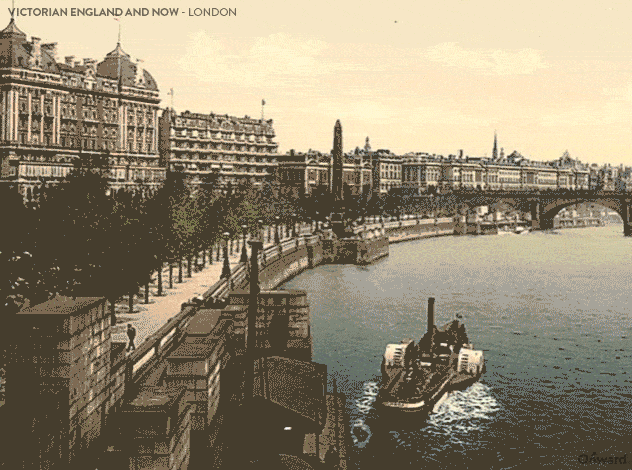
Click on the image to see more
Manchester – Victoria Street
The cobblestones of Victoria Street may have long since vanished to make way for the motor car, but the controversial statue of Oliver Cromwell that disappears from one photo to the next could be making a comeback. The statue was a gift to the city from Elizabeth Heywood, wife of 19th-century mayor Abel Heywood, in honour of her late husband Thomas Goadsby, the city’s previous mayor. But it was Cromwell’s political divisiveness as much as the serial mayor-marrying of Elizabeth Heywood that resulted in it being put on the street instead of its original destination inside Manchester Town Hall. Cromwell was relocated to Wythenshawe Hall in the 1980s, but seems set to return to city life when the area around the 15th-century gothic cathedral (right) is redeveloped and rebranded as the ‘Medieval Quarter’ in the near future.
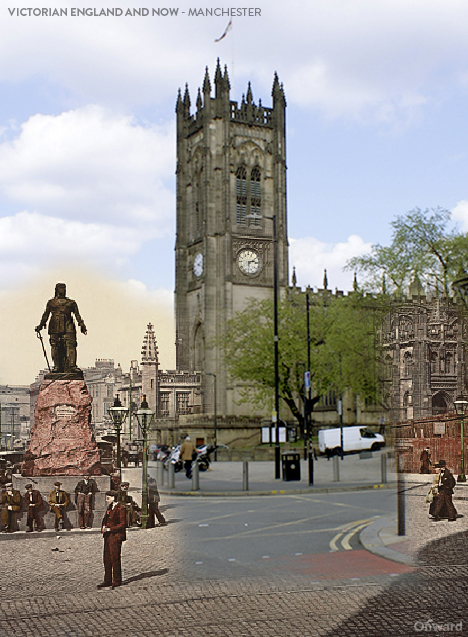
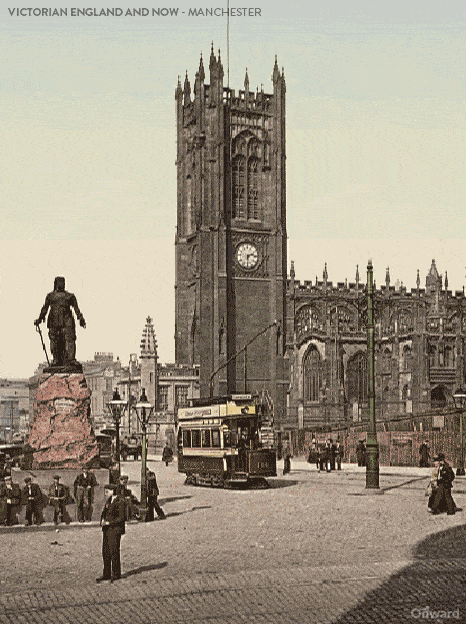
Click on the image to see more
Newcastle – Black Gate and Castle
The ‘Black Gate’ drawbridge post built in 1250, and Henry II’s 842-year-old castle (built on the site of the fortress that gave Newcastle its name) are listed buildings, so they haven’t changed much between Victorian times and now. The most significant change is the building that’s popped up between them in the photo – and this one’s now listed, too. Built in the classical style as the Northumberland County Hall in 1910 and expanded upwards and outwards in 1933, it is now a hotel. The bridge has become a railway viaduct for the East Coast mainline to Scotland.
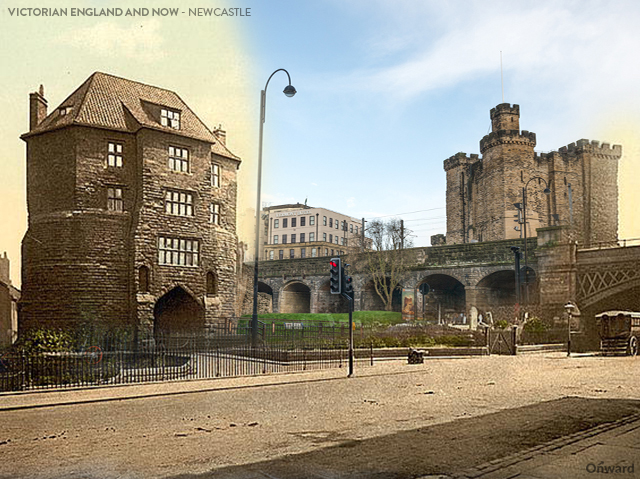
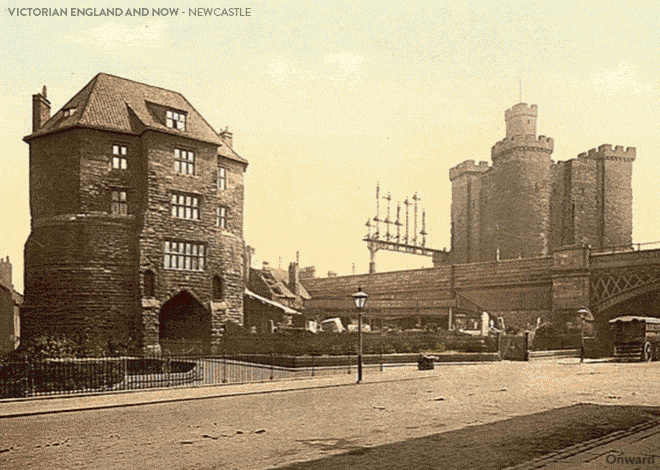
Click on the image to see more
Scarborough – the Spa at South Bay
The city of Scarborough can trace its fortunes to the 17th-century discovery of a mineral spring with purportedly medicinal properties. Word spread and the spa became a fashionable tourist destination, and over the next two centuries a sequence of structures of varying impressiveness (beginning with a simple wooden terrace) overlooked the waters. With the arrival of a rail connection, the spa complex (left) was built, and then restored and expanded after a fire in the 1880s. The key difference between the pictures is the enclosure of the Sun Court in the later image. Although the Grand Hall seats 2,000, the Sun Court is an altogether more wholesome place to catch a performance by the Scarborough Spa Orchestra, who have performed there since 1912.
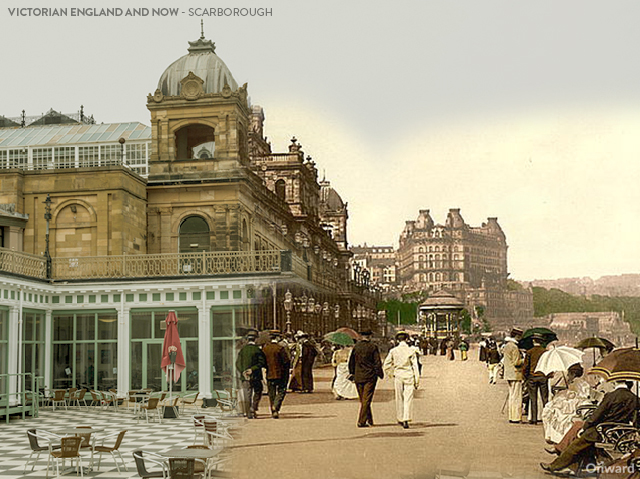
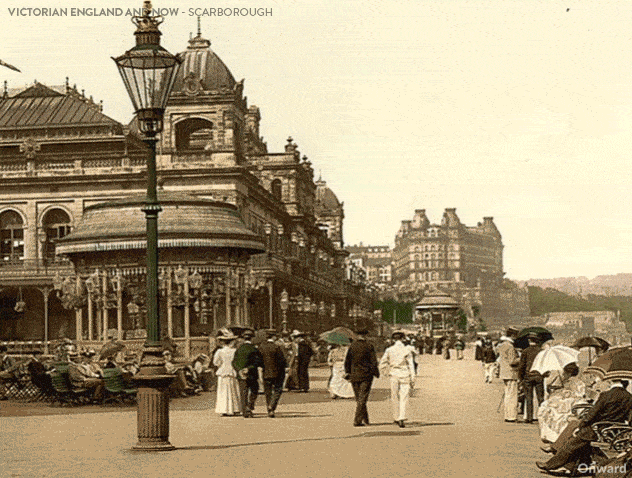
Click on the image to see more
Worthing – Marine Parade
The pier at Worthing was first opened in 1862, with the South Pavilion in the background of the original photo added in 1889. The pavilion survived a gale that washed away much of the pier in 1914, but disappeared behind the bigger and more modern Pier Pavilion built at the shore end in 1926, which dominates today’s photo. In the 1930s, the South Pavilion perished in a fire and passers-by hurried to dismantle the pier to stop the flames spreading to the new pavilion. The South Pavilion was subsequently rebuilt in the Streamline Moderne style – kind of art deco-meets-nautical. It later became a nightclub, before returning to use as a café and entertainment venue, while the pavilion in the modern picture is mostly in use as a theatre.

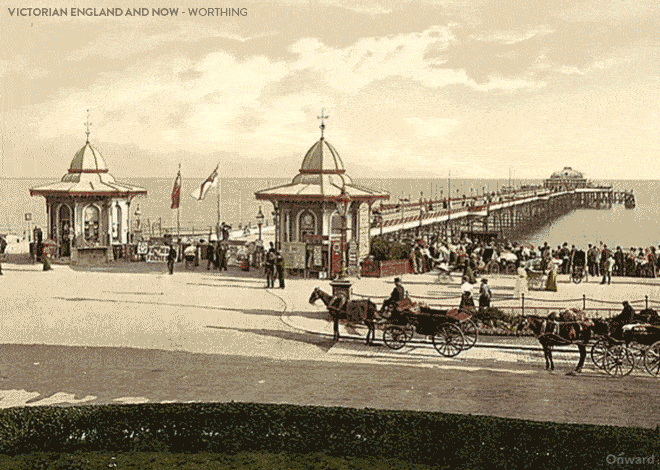
Click on the image to see more
The landscape and the built environment around us evolve in ways that are rarely predictable – and the features that remain offer a flashback to different times. Which modern features of your hometown do you think will still be visible one hundred years from now?
Sources
BBC. (2014). History of the Hall. bbc.co.uk
Craig, Z. (2017). Secrets of Waterloo Bridge. londonist.com
England’s North East. (2019). Roman Newcastle. englandsnortheast.co.uk
Goring By Sea. (2019). WORTHING. goring-by-sea.uk.com
Historic England. (2019). The Spa. historicengland.org.uk
Library of Congress. (2019). Photochrom Prints. loc.gov
Manchester Cathedral. (2019). History. manchestercathedral.org
Middleton, B. (2014). Colston Hall. rifemagazine.co.uk
Milner, L. (2019). St Augustine’s Parade. bristolstories.org
The Economist. (2018). Obelisk diplomacy. economist.com


